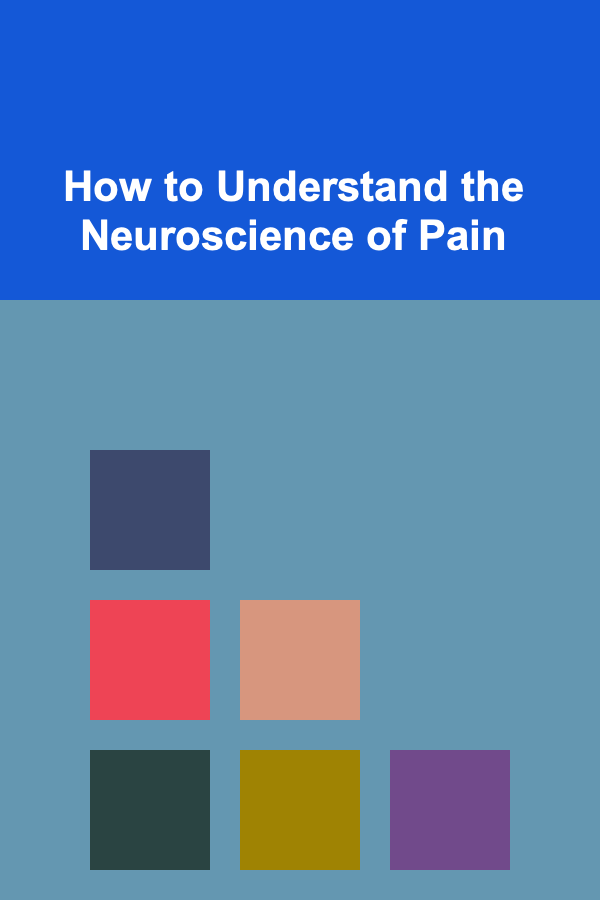
How to Understand the Neuroscience of Pain
ebook include PDF & Audio bundle (Micro Guide)
$12.99$10.99
Limited Time Offer! Order within the next:

Pain is one of the most fundamental experiences of human existence, yet it remains one of the most complex and least understood phenomena in neuroscience. Whether it's a temporary ache or a chronic condition, pain can dramatically alter a person's life. In this article, we will explore the neuroscience of pain, examining how pain is processed in the brain and the body, the different types of pain, how chronic pain develops, and the latest research on pain management.
What is Pain?
Pain, at its core, is an unpleasant sensory and emotional experience associated with actual or potential tissue damage. However, its definition goes beyond just a physical sensation. Pain also involves a cognitive, emotional, and psychological component. The International Association for the Study of Pain (IASP) defines pain as "an unpleasant sensory and emotional experience associated with, or resembling that associated with, actual or potential tissue damage." This emphasizes that pain is not merely a physiological response, but an intricate experience influenced by various factors.
Acute vs. Chronic Pain
Pain can be broadly categorized into two main types: acute pain and chronic pain.
- Acute Pain: This type of pain occurs suddenly, usually in response to injury or tissue damage. It is typically short-lived, lasting for a few minutes to weeks, and fades as the injury heals. Acute pain serves a protective function, alerting the body to harm and encouraging behaviors that prevent further injury.
- Chronic Pain: When pain persists for months or even years, it is considered chronic pain. This type of pain often continues long after the initial injury has healed. Chronic pain can arise from conditions like arthritis, fibromyalgia, or nerve damage, and it can significantly affect an individual's quality of life.
Understanding pain requires a grasp of both its nociceptive (i.e., related to tissue damage) and neuropathic (i.e., related to nerve injury or dysfunction) components. The neuroscience of pain helps us unravel how these different types of pain arise and how the brain processes and responds to them.
The Neurobiological Basis of Pain
Pain begins with the activation of specialized sensory receptors known as nociceptors, which are found in the skin, muscles, joints, and internal organs. These receptors are designed to detect noxious (harmful) stimuli like heat, pressure, or chemicals that could lead to tissue damage. When activated, nociceptors send electrical signals along nerve fibers to the spinal cord and ultimately to the brain, where the sensation of pain is perceived.
1. Nociception: The Initial Detection of Pain
Nociceptors are specialized sensory neurons that respond to potentially damaging stimuli. These receptors are activated by:
- Thermal stimuli: Extreme heat or cold.
- Mechanical stimuli: Pressure, vibration, or stretching.
- Chemical stimuli: Harmful chemicals that are released during tissue damage or inflammation.
Once activated, nociceptors generate electrical impulses that travel along A-delta fibers (which are responsible for sharp, immediate pain sensations) and C fibers (which convey dull, throbbing pain). These impulses travel toward the spinal cord, where they are relayed to higher brain regions for processing.
2. Spinal Cord and Pain Transmission
The first stop for pain signals in the central nervous system is the spinal cord . Upon entering the spinal cord, nociceptive signals synapse (connect) with second-order neurons in the dorsal horn of the spinal cord. From there, the signals ascend to the brain via the spinothalamic tract, which is the primary pathway for transmitting pain information.
In the spinal cord, pain signals are modulated by both ascending and descending pathways. Ascending pathways carry the pain signals to the brain, while descending pathways can either amplify or inhibit pain signals.
3. The Brain: Processing Pain Signals
Once the pain signals reach the brain, they are processed in several key areas:
- Thalamus: The thalamus acts as a relay station for pain signals, directing them to higher cortical areas.
- Somatosensory Cortex: The somatosensory cortex is responsible for localizing the pain and determining its intensity and nature. It helps us identify whether the pain is sharp, dull, burning, or aching.
- Anterior Cingulate Cortex (ACC): The ACC plays a role in the emotional aspect of pain, processing the unpleasantness and the emotional response to pain. It is also involved in the perception of suffering.
- Insular Cortex: The insula is involved in the integration of sensory, emotional, and cognitive aspects of pain, helping to form the overall experience of pain.
Pain perception is not just about detecting a noxious stimulus but involves an intricate network of brain regions that interpret the pain's sensory, emotional, and cognitive components. The way pain is experienced can vary significantly from one individual to another, depending on factors such as psychological state, previous experiences, and genetic predisposition.
How Pain Becomes Chronic
While acute pain is a protective mechanism that resolves after the underlying injury heals, chronic pain persists long after the injury has healed. Chronic pain can occur when the nervous system becomes sensitized, amplifying the pain signals sent to the brain. This phenomenon is referred to as central sensitization.
1. Peripheral Sensitization
Peripheral sensitization occurs when nociceptors in the injured area become more sensitive to stimuli. This can happen as a result of inflammation or tissue damage, leading to an exaggerated pain response. For example, after an injury, the area around the wound may become hyperalgesic (more sensitive to pain) due to the release of pro-inflammatory mediators like prostaglandins and bradykinin.
2. Central Sensitization
Central sensitization refers to changes that occur in the central nervous system, specifically in the spinal cord and brain, that lead to an exaggerated pain response. This can occur after prolonged or repeated nociceptive input, causing neurons in the spinal cord and brain to become more excitable and responsive to stimuli. The result is an increased perception of pain, even in the absence of ongoing tissue damage.
In central sensitization, neurons that typically respond to noxious stimuli may begin to respond to non-noxious stimuli, leading to phenomena such as allodynia (pain caused by normally non-painful stimuli) and hyperalgesia (increased sensitivity to painful stimuli).
3. Neuropathic Pain
Neuropathic pain is a form of chronic pain that arises from damage to the nervous system itself, often due to conditions like diabetes, shingles, or multiple sclerosis. It can result from injury to the peripheral nerves (peripheral neuropathy) or damage to the central nervous system (central neuropathy). Unlike nociceptive pain, which is caused by tissue damage, neuropathic pain arises from dysfunction or injury in the nervous system, and it can manifest as burning, tingling, or shooting pain.
The mechanisms underlying neuropathic pain are complex and involve both peripheral and central sensitization. Damage to the nerves can lead to abnormal signaling in the nervous system, leading to persistent pain. Additionally, changes in the brain and spinal cord can amplify the pain signals, leading to a vicious cycle of chronic pain.
The Psychological and Emotional Aspects of Pain
While the biological mechanisms of pain are crucial, it is essential to recognize the significant role that psychological and emotional factors play in pain perception. Pain is not purely a sensory experience but also involves a cognitive and emotional response. The cognitive appraisal of pain, including an individual's beliefs about pain and its potential consequences, can significantly influence how pain is perceived.
1. The Role of Emotion in Pain
Pain and emotion are intricately linked, with one influencing the other. Emotional states such as fear, anxiety, and depression can amplify the perception of pain. In contrast, positive emotional states or distractions can reduce the intensity of pain. The anterior cingulate cortex (ACC) and insular cortex are brain regions involved in processing both pain and emotional responses, highlighting the overlap between the sensory and emotional components of pain.
2. The Influence of Cognitive Factors
An individual's interpretation of pain can also affect how it is experienced. For instance, individuals who perceive their pain as uncontrollable or threatening may experience higher levels of distress, leading to a more intense pain experience. Cognitive-behavioral therapy (CBT) has been shown to be effective in treating chronic pain by helping patients reframe their thoughts and develop coping strategies that reduce the emotional and cognitive impact of pain.
3. Pain and Memory
Pain perception is also influenced by memory. People who have had a traumatic or prolonged pain experience may develop heightened pain sensitivity, even in response to less severe stimuli. This can contribute to the persistence of chronic pain, where past painful experiences continue to influence current pain perception.
Pain Management: What the Neuroscience Tells Us
Given the complexity of pain, managing it requires a multidisciplinary approach. The neuroscientific understanding of pain has led to the development of various treatments that aim to alleviate pain by targeting different aspects of the pain pathway.
1. Pharmacological Treatments
- Nonsteroidal anti-inflammatory drugs (NSAIDs): These drugs reduce inflammation, which is often a key contributor to acute pain. NSAIDs like ibuprofen inhibit the production of prostaglandins, which are chemicals that promote inflammation and pain.
- Opioids: Opioid analgesics, such as morphine and oxycodone, are powerful painkillers that act on opioid receptors in the brain and spinal cord. They are particularly effective for severe acute pain but carry the risk of addiction and side effects, making their use in chronic pain controversial.
- Antidepressants and Anticonvulsants: Medications like amitriptyline (an antidepressant) and gabapentin (an anticonvulsant) are often used to treat chronic neuropathic pain. These drugs work by modulating neurotransmitters involved in pain processing in the brain and spinal cord.
2. Non-Pharmacological Approaches
- Cognitive-Behavioral Therapy (CBT): CBT is often used in conjunction with other treatments to address the emotional and cognitive aspects of pain. It helps patients develop coping strategies to manage pain more effectively.
- Physical Therapy and Exercise: Physical therapy aims to reduce pain and improve function by targeting the muscles, joints, and tissues that may be contributing to pain. Exercise has been shown to reduce pain sensitivity and improve mood, helping to alleviate both the physical and emotional aspects of chronic pain.
- Mindfulness and Meditation: Techniques like mindfulness meditation can reduce pain perception by altering the brain's response to pain. Research suggests that mindfulness practices can reduce activity in pain-processing regions of the brain, helping individuals cope with chronic pain more effectively.
Conclusion
The neuroscience of pain is a multifaceted and rapidly evolving field that has uncovered valuable insights into the mechanisms underlying pain perception. From the activation of nociceptors to the complex brain networks involved in processing pain, our understanding of pain is continuously advancing. The interplay between biological, psychological, and emotional factors in pain perception highlights the need for a comprehensive approach to pain management.
As research progresses, it is likely that new treatments will emerge that target specific pain pathways, offering hope for individuals suffering from chronic pain. Understanding the neuroscience of pain not only provides insight into how pain affects the body and brain but also opens the door to more effective and personalized approaches to pain relief.

How to Make Your Bed a Space-Saving Solution
Read More
How to Pack for a Festival: A Checklist for Music, Fun, and Comfort
Read More
What Are the Benefits of Using Labels for Home Organization?
Read More
How to Understand Blockchain for Internet Security
Read More
How to Develop Discipline for Consistent Weight Loss
Read More
The Step-by-Step Guide to Basic Car Maintenance
Read MoreOther Products

How to Make Your Bed a Space-Saving Solution
Read More
How to Pack for a Festival: A Checklist for Music, Fun, and Comfort
Read More
What Are the Benefits of Using Labels for Home Organization?
Read More
How to Understand Blockchain for Internet Security
Read More
How to Develop Discipline for Consistent Weight Loss
Read More